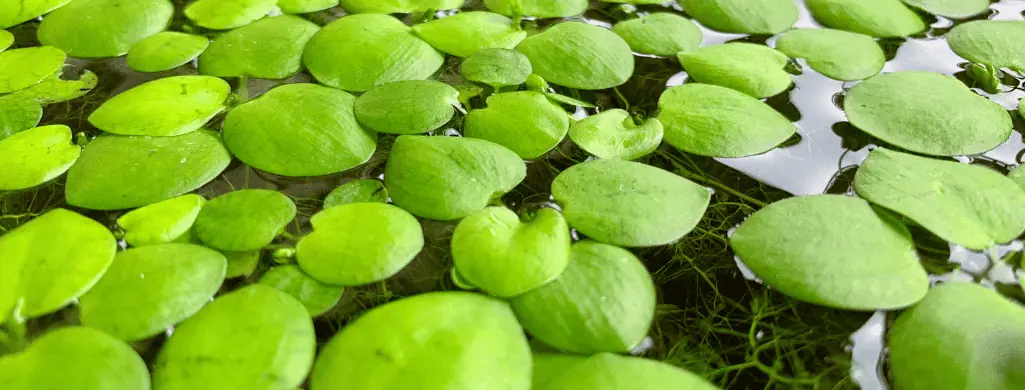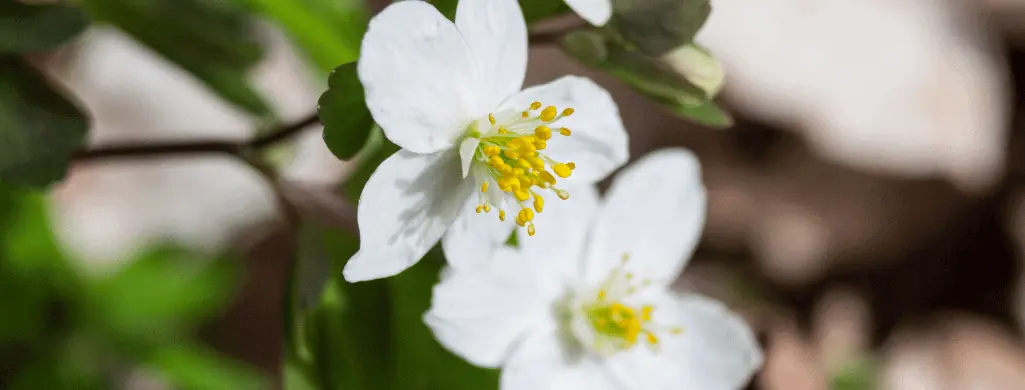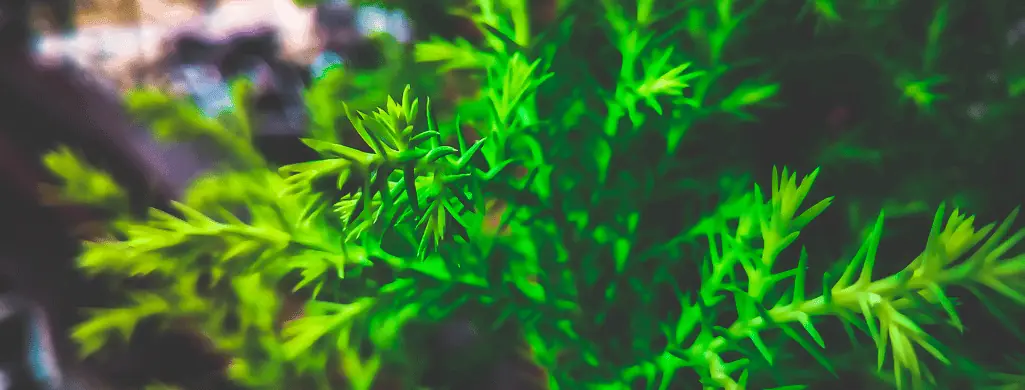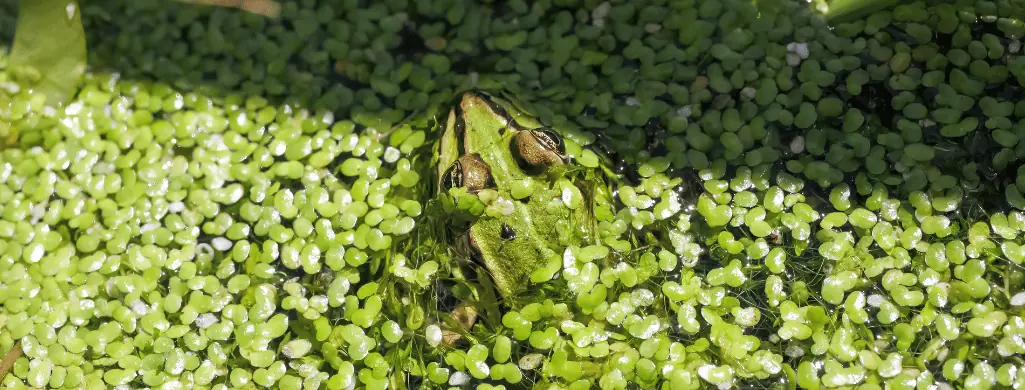It’s no secret how much betta fish love a heavily planted tank.
Floating plants have specific advantages. They provide shade, hiding spots, and a place for your betta fish to make a bubble nest.
Here are 18 beautiful floating betta plants. We’ve got something for any betta tank setup!
1. Amazon Frogbit (Limnobium Laevigatum)

Frogbit is one of the most popular floating plants for the betta tank.
It provides great cover for smaller critters like betta fry, shrimp, and snails.
One of its best qualities is how Amazon Frogbit helps control nitrate levels in the aquarium water.
Like many aquatic plant species, Frogbit is a great source of oxygen for the tank.
But without proper maintenance, it will begin to deplete the tank of needed minerals.
You’ll want to use at least a 10-gallon tank. This ensures both your betta and your plants get the nutrients they need.
Amazon Frogbit’s lighting requirements are standard, making them one of the easier freshwater plants to care for.
| pH | 6.0-7.5 |
| Temperatures | 68-85° degrees Fahrenheit (20-29°C) |
| Hardness | 0-12 dGH |
2. Dwarf Water Lettuce (Pistia Stratiotes)

Don’t let the name deceive you; Dwarf Water Lettuce will grow to be enormous in its natural environment!
You don’t see such broad leaves within the confines of an aquarium. In a betta setup, florets don’t get larger than about 4″ inches wide.
Be careful with lighting levels for this plant. Anything too bright or harsh will cause wilting and yellowing.
Ideally, this plant gets a shadier betta aquarium to live in.
With proper conditions, Dwarf Water Lettuce draws in toxins from the water column.
This includes ammonia and nitrates, two of the most harmful chemicals in the tank.
Furthermore, this plant takes fuel away from algae. This means you get an all-around cleaner tank for your trouble!
Be sure to use a tank of 10 gallons or more.
| pH | 6.0-7.5 |
| Temperature | 72-86° degrees Fahrenheit (22-30°C) |
| Hardness | 3-8 dGH |
3. Water Sprite (Ceratopteris Thalictroides)

Also known as Water Fern or Indian Fern, this plant is widely available in pet stores.
One reason it’s so popular is its versatility. Water Sprite can float at the top of the tank or be rooted in the substrate.
This is a great plant for novice aquarists looking to assemble a relatively cheap but attractive betta tank.
But it is by no means something for only beginners! This plant is beautiful and has a soft, bushy appearance.
Water Sprite makes any aquatic setup look livelier!
It’s also a very adaptable plant, but sometimes difficult to keep under control. Keep a regular pruning schedule.
| pH | 6.0-7.5 |
| Temperature | 70-82° degrees Fahrenheit (21-27°C) |
| Hardness | Any |
4. Red Root Floater (Phyllanthus Fluitans)
Red Root Floaters are easy to tell from other floating plants thanks to their color and heart-like leaf shapes.
But there’s more to this hardy plant than its appearance. It oxygenates the water for you and helps manage algae growth.
Its dense but thin roots also dangle into the water and make ample hiding places for your fish and shrimp.
Red Root Floaters can thrive in a smaller tank than other floating plants. If you keep just one betta in a 5-gallon tank, this one is for you!
They cover the water’s surface pretty quickly when you meet basic care requirements.
This is actually good to an extent; the plant requires bright lighting to look red.
With enough leaves at the water surface, the light trickles down to your betta in more manageable doses.
| pH | 6.5-7.5 |
| Temperature | 70-82° degrees Fahrenheit (21-27°C) |
| Hardness | 0-12 dGH |
5. Water Spangles (Salvinia Minima)

Water Spangles are a type of aquatic fern with vibrant green leaves.
This is a versatile plant, which makes the care difficulty easy. But Water Spangles grow at an alarming speed.
In fact, in natural environments, they are considered invasive.
We recommend using a tank of 10 gallons or more to accommodate the rapid growth.
| pH | 6.0-8.0 |
| Temperature | 72-80° degrees Fahrenheit (22-26°C) |
| Hardness | 0-15 dGH |
6. Water Wisteria (Hygrophila Difformis)

Native to the Indian subcontinent, Water Wisteria grows naturally in marshy environments.
While it needs adequate lighting, this aquatic plant species is hardy. Moderate lighting is fine, and the overall care difficulty for this species is low.
Like most aquarium plants, you need to prepare yourself for fast growth.
Use a tank of 10 gallons or more, and plan on trimming the Wisteria regularly.
| pH | 6.5-7.5 |
| Temperature | 70-82° degrees Fahrenheit (21-27°C) |
| Hardness | 2-15 dGH |
7. Floating Crystalwort (Riccia Fluitans)

Crystalwort is a relatively new plant for the closed aquarium. It’s only been used regularly since the 1990s!
Usually, this plant needs special or high-intensity lighting. But when you use it as a floating plant at the water’s surface, lower lighting is just fine.
If you’re looking for something extremely low maintenance, this one isn’t for you.
The care difficulty is slightly heightened because this plant does best if you give it carbon dioxide injections.
| pH | 6.0-8.0 |
| Temperature | 70-80° degrees Fahrenheit (21-26°C) |
| Hardness | 0-10 dGH |
8. Java Moss (Taxiphyllum barbieri)
Java Moss is often compared to Crystalwort, because they have similar uses.
However, this is the more popular of the two plants because the former is a more low-maintenance plant.
Java Moss doesn’t have any need for special or high-intensity lighting, nor does it need carbon dioxide injections.
It may benefit from CO2, but it is not a must.
Like Crystalwort, Java Moss makes a great carpet or floating plant. Java also sticks to surfaces, though, in a way other plants do not.
For example, a piece of wood floating near the surface would attract some clinging.
| pH | 6.0-8.0 |
| Temperature | 60-82° degrees Fahrenheit (16-27°C) |
| Hardness | 0-30 dGH |
9. Giant Duckweed (Spirodela polyrhiza)

The leaves of Giant Duckweed are small and have a beautiful color of pale green.
This popular plant is great for absorbing waste in the tank before algae can form.
It also raises oxygen levels in the betta aquarium, improving water quality overall.
Remember, no plant will eliminate the need for water changes. But with good care, your plants will certainly help with water chemistry!
Even better, Duckweed thrives in a huge variety of water temperatures. The care difficulty is really low, so this is a great starter plant for the beginner aquarist.
| pH | 6.5-7.5 |
| Temperature | 60-90° degrees Fahrenheit (15-30°C) |
| Hardness | 2-15 dGH |
10. Banana Plant (Nymphoides Aquatica)

Sometimes we call these Banana Lilies because of their floral appearance.
They have an appealing lily pad look, though, of course, they’re much smaller. Sometimes you even get to see little white blossoms!
They’re beautiful and surprisingly low-maintenance plants.
Liquid fertilizer is helpful but not usually necessary. They have a way more manageable growth rate than most floating aquarium plants.
Make sure there is minimal water movement for the Banana Plant. Your betta also likes an extremely gentle current, so they’re ideal tank mates!
| pH | 6.0-7.5 |
| Temperature | 68-82° degrees Fahrenheit (20-27°C) |
| Hardness | 0-4 dGH |
11. Mosquito Fern (Azolla Caroliniana)

Also called Fairy Moss, this attractive plant has a rapid growth rate!
Like other floaters, it helps prevent algae growth by excess nutrients from the habitat.
It does also protect bettas from light. This is great because bright light is too harsh for your fish.
But when you have lots of plants, it’s necessary sometimes.
Keep in mind when you look at the water parameters for Mosquito Fern, this plant is very flexible.
It needs access to light, and it’s best not to go too far out of the ideal pH or water temperature range.
But they survive just fine in a much broader range of environments, including pH levels as high as 10.
This, of course, would not be a safe habitat for a betta fish. But it’s interesting nonetheless!
| pH | 4.0-8.0 |
| Temperature | 68-78° degrees Fahrenheit (20-25°C) |
| Hardness | 0-18 dGH |
12. Hornwort (Ceratophyllum Demersum)

Hornwort is another great floating plant for beginner betta keepers.
This one takes medium amounts of light, similar to what your betta would already want.
Using a bright light or a particularly dim aquarium light causes shedding and discoloration.
They don’t require any fertilizer to grow, though it certainly would not hurt.
Hornwort works best as a floating plant, because it doesn’t grow roots like other plants.
If you want to, though, it’s possible to weigh one end of it down or bury it in the substrate.
| pH | 6.0-8.0 |
| Temperature | 60-86° degrees Fahrenheit (15-30°C) |
| Hardness | 3-15 dGH |
13. Whorled Pennywort (Hydrocotyle Verticillata)

These unique betta tank plants are often called Shield Pennywort or Whorled Marsh Pennywort.
If you’re looking for a rooted plant for betta fish, this isn’t the one. Whorled Pennywort needs plenty of light, too much for a betta to be comfortable with.
However, using it as a floating plant acts as a shield for your fish.
The brighter light benefits your plants without harming the other life in your aquarium!
These work just fine as beginner plants, but CO2 injections are a good idea.
| pH | 6.0-7.5 |
| Temperature | 70-82° degrees Fahrenheit (21-27°C) |
| Hardness | 2-10 dGH |
14. Duckweed (Lemna minor)

Common Duckweed is often overlooked as one of the less exciting aquatic plants.
But it comes with lots of benefits you don’t want to miss. It helps control nitrogen, for one thing.
In fact, according to the US Department of Agriculture, Common Duckweed has become a tool for cleaning up waterways affected by nitrogen and phosphorus.
Your aquarium is not being affected by agricultural runoff, of course. But controlling nitrogen and other chemicals is still crucial to the health of your fish tank.
Despite the ideal water parameters we listed for you, Duckweed tolerates slightly wider ranges of pH and temperature.
| pH | 5.0-8.0 |
| Temperature | 65-80° degrees Fahrenheit (18-26°C) |
| Hardness | 2-15 dGH |
15. Anacharis (Elodea Canadensis)

This plant goes by a lot of different names: American Waterweed, Common Waterweed, Elodea, Anacharis, Canadian Waterweed, Common Elodea, American Elodea.
I think you get the idea!
You might notice Elodea likes the water just a little cooler than the ideal temperature for your betta fish.
While the plant may grow a bit slower, keeping it at 78° degrees Fahrenheit (25.5°C) is okay.
However, your betta will also be okay going just one degree cooler than their preferred range.
| pH | 6.0-7.5 |
| Temperature | 50-77° degrees Fahrenheit (10-25°C) |
| Hardness | 3-8 dGH |
16. Indian Toothcup (Rotala Indica)

Notice the unique leaves on this plant and how they look almost like teeth.
Depending on the environment, you’ll see green leaves or red and pink ones!
This is a relatively low-maintenance plant and very forgiving of any mistakes a beginner might make.
Though it is a great plant for your freshwater aquarium, this plant is a survivalist and can inhabit brackish waters too!
| pH | 5.0-7.0 |
| Temperature | 64-86° degrees Fahrenheit (18-20°C) |
| Hardness | 0-30 dGH |
17. Cabomba (Cabomba Caroliniana)

Cabomba plants are beautiful and often colorful. In good health, these bushy plants may have red, purple, and green hues.
A few different types of Cabomba are sold according to their colors. The Red or Purple Cabomba plant is one of the more difficult ones to find.
But it sure is beautiful!
Cabomba plants may show small flower buds if well cared for. They make any betta tank a little bit prettier.
| pH | 6.5-7.5 |
| Temperature | 72-82° degrees Fahrenheit (22-27°C) |
| Hardness | 3-8 dGH |
18. Water Velvet (Azolla Filiculoides)

This plant is small but mighty, often used to help regulate nitrogen in the tank.
Water Velvet is related to the aforementioned Fairy Moss. They are both often referred to as Mosquito Fern.
But they tolerate different ranges of water temperatures and lighting.
Water Velvet needs at least a 10-gallon aquarium to grow. Bear in mind, this plant is usually grown in larger bodies of water like ponds.
It’s easy to get it the nutrients it needs. But keep an eye on it so it doesn’t outgrow the tank!
| pH | 5.0-7.0 |
| Temperature | 60-80° degrees Fahrenheit (16-26°C) |
| Hardness | 5-25 dGH |
Floating? More Like Gloating Betta Plants
These are some of the most beautiful plants you’ll find for the aquarium, not to mention beneficial.
Personally, my favorites are those with tiny flowers. The Banana Plant and Cabomba are both lovely.
Remember, whatever you pick, to ensure it will do well in your betta’s tank.
Every plant listed here will be a great tank mate to a betta. But you must line the temperature, pH, and hardness up right.
Here’s another post you might like on toxic plants for betta fish.


